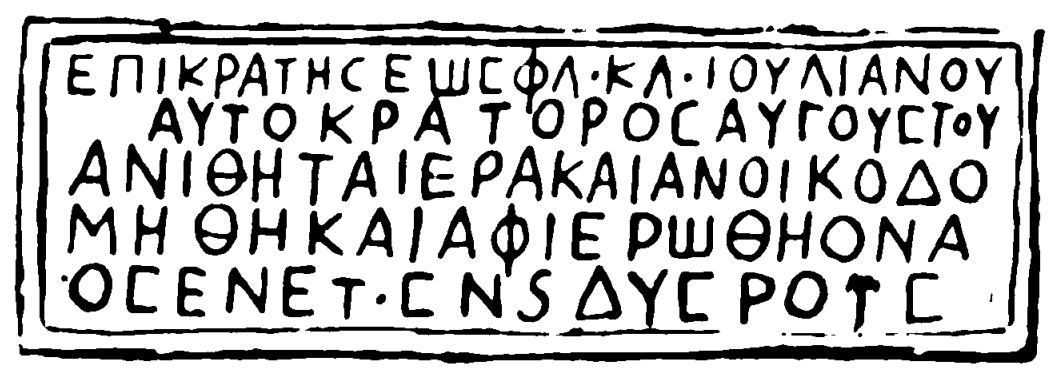Anz
Anz contains inscription evidence for a pagan Temple restored by Emperor Julian the Apostate.
- 108. 'Anz. On a lintel, well engraved.
 108
108
'Anz. On a lintel, well engraved.
Dussaud et Macler (1902)- Επί κρατήσεως Φλ. Κλ. Ιουλιάνου αυτοκράτορος αυγούστου αν(ε) θη τα ιερά και ανοικοδομήθη και αφιερώθη ο ναός εν έτ (ει) σνς' δύσ (τρου [ε ] .
- During the reign of Fl. Cl. Julian Augustus emperor, the sacrifices have been renewed and the temple was restored and consecrated, in the year 256, the 5 Dustros.
- Inscription dated March 5, 362 CE. Around the middle of the year
361, the Emperor Julian officially made an act of paganism by
same year. Our inscription provides indirect evidence that the year 256 of the era of Bostra must be counted from March 22, 361 to
March 22, 362. Indeed, the order to reopen the pagan temples in
the whole empire was given by Julian on December 11, 361, the day of
his entry into Constantinople. The edict was known in Alexandria on February 4
February 362. The Anz inscription proves that on March 5 the restoration of paganism took place.
Officially located in the Hauràn region. The Temple of Venus at Heliopolis of Syria
was raised in April or May and the sanctuary of Daphne in October of the same year1.
We can still point out as monuments bearing the trace of the restoration of paganism
in Syria under Julian the curious millenials noted by Father Germer-Durand2 and the hawk, bearing at the
the name of Julian as a manifestation of the divinity of this
emperor, found at Arsouf by M. Clermont-Ganneau3.
Footnotes
1 Cf. G. Goyau , Chronol. de l'emp. romain.
2 GERMER- DUKAND , Rev. Bibl. , 1899, p. 35-39; cf. plus baut p. 478 , n . 1 .
3 CLERMONT-GANNEAL', Mission en Palestine et en Phénicie , Archives des missions scient , et litt . , 3 série , t . XI , pl. III , II
- 108. 'Anz. Sur un linteau, bien gravée.
 108
108
'Anz. Sur un linteau, bien gravée.
Dussaud et Macler (1902)- Επί κρατήσεως Φλ. Κλ. Ιουλιάνου αυτοκράτορος αυγούστου αν(ε) θη τα ιερά και ανοικοδομήθη και αφιερώθη ο ναός εν έτ (ει) σνς' δύσ (τρου [ε ] .
- Sous le règne de Fl . Cl. Julien empereur auguste , les sacrifices ont été renouveles et le temple a été restauré et consacré , en l'année 256 , le 5 Dustros. »
- Inscription du 5 mars 362 de notre ère. Vers le milieu de l'an
361, l'empereur Julien fit officiellement acte de paganisme par
même année. Notre inscription fournit une preuve indirecte que l'an 256 de l'ère de Bostra doit être compté du 22 mars 361 au
22 mars 362. En effet, l'ordre de rouvrir les temples païens dans
tout l'empire fut donné par Julien le 11 décembre 361 , jour de
son entrée à Constantinople. L'édit fut connu à Alexandrie le 4 fé
vrier 362. L'inscription de ‘ Anz prouve que le 5 mars la restaura tion du paganisme eut
lieu officiellement dans la région du Hau ràn. Le temple de Vénus à Héliopolis de Syrie
fut relevé en avril ou mai et le sanctuaire de Daphné en octobre de la même année1.
On peut signaler encore comme monuments portant la trace de la restauration du paganisme
en Syrie sous Julien les curieux mil liaires relevés par le P. Germer-Durand2 et l'épervier, portant au
cou le nom de Julien comme manifestation de la divinité de cet
empereur, trouvé à Arsouf par M. Clermont-Ganneau3.
Footnotes
1 Cf. G. Goyau , Chronol. de l'emp. romain.
2 GERMER- DUKAND , Rev. Bibl. , 1899, p. 35-39; cf. plus baut p. 478 , n . 1 .
3 CLERMONT-GANNEAL', Mission en Palestine et en Phénicie , Archives des missions scient , et litt . , 3 série , t . XI , pl. III , II
 ILS 9465
ILS 9465Inscription for Temple Restoration by Emperor Julain the Apostate
Inscriptiones Latinae Selecta vol. 3
- 9465 έπi κρατήσεως Φλ. Κλ. 'Ιονλιανου | αύτσχράτορος Αv-γούστου | άνΕ$η1 τά iερά χάi άνοινοόο | μή η1, καi άφιερώθη δ να|ός έν έτ. σνς3 Dύσ[τ]ρον ς4.
- In vico Auranitidis 'Anz, a Bostra circ. 20 mill. pass. ( Dussaud et Macler Nouv. Archives des miss. scientif. 10, 1902 p. 678 n. 608). — 1) άνείθη.
- Templa aperiri iusserat Iulianus, cf. Amm. Marcell. 22, 5, 2. — 2)
- Cf. supra N. 4197. —3)
- Anno (provinciae Arabiae) CCLVI (p. Chr. 361/2).
- Provincia Arabia annos computabat a d. 22 Mart. 106 p. Chr. — 4)20 Febr. (cf. Ideler 1, 437).
Dussaud, R. and F. Macler (1903). Mission dans les régions désertiques de la Syrie moyenne, Imprimerie Nationale.
ILS (Inscriptiones Latinae Selecta) vol. 3 9465
Oikonomides A. (1987) “Ancient inscriptions recording the restoration of GrecoRoman shrines by the Emperor Flavius Claudius Julianus (361–363 A.D.)”, AncW
15 (1987) 37–42.
